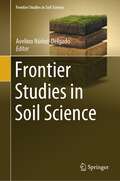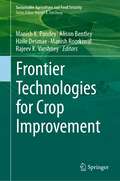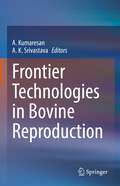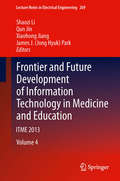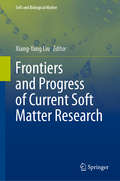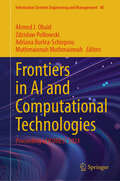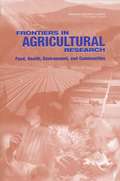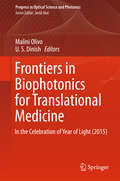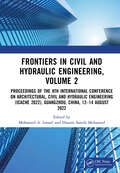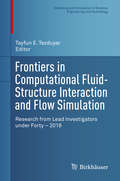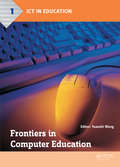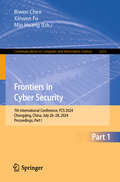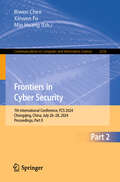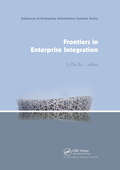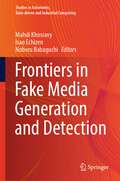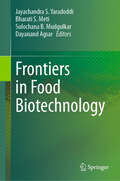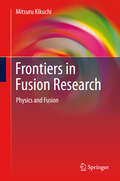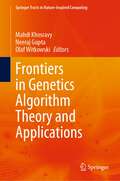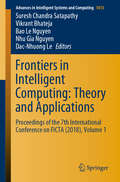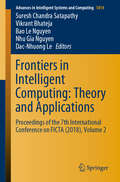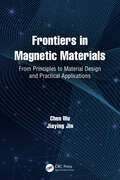- Table View
- List View
Frontier Studies in Soil Science (Frontier Studies in Soil Science)
by Avelino Núñez-DelgadoThis is the first book where top researchers focus on presenting new research proposals in soil science. All the authors contributing to the book have a solid background and experience in specific fields of soil science, allowing them to propose the critical lines of future development in their respective and particular paths of cut-edge investigation. The primary audiences for the work are scientists/researchers working in these fields, as well as students interested in the views from top scientists on recent and future trends in the area, and all those in the overall society desiring to be aware of possible pathways for the future of soil science.
Frontier Technologies for Crop Improvement (Sustainability Sciences in Asia and Africa)
by Rajeev K. Varshney Manish Roorkiwal Manish K. Pandey Alison Bentley Haile DesmaeThis edited book is a compilation of information on existing frontier technologies in agriculture, such as driving modernized crop improvement programs via digitalization, mechanization and automation, artificial intelligence, speed breeding. The major focus of the book is on the technologies related to genetic gain, nutrition and food safety. Agriculture is core to industry as well as human civilization and sustainability of the society. Therefore, advancement and investment of technology is essential for enhancing the quality and quantity of the produce for ensuring food and nutritional security. The frontier technologies bring drastic change in the way of functioning leading to multi-fold increase in efficiency and outcome. Chapters in this book addresses a particular enabling technology and forward-looking strategy. Compiled information with successful deployment examples of these technologies is not been made available from a single platform, therefore, this volume is a unified compilation of information from international experts. The book is a relevant reading material for students, researchers, academicians and industry players in agriculture.
Frontier Technologies for Infrastructures Engineering: Structures and Infrastructures Book Series, Vol. 4 (Structures and Infrastructures)
by Shi-Shuenn Chen Alfredo H-S.AngAn exclusive collection of papers introducing current and frontier technologies of special significance to the planning, design, construction, and maintenance of civil infrastructures. This volume is intended for professional and practicing engineers involved with infrastructure systems such as roadways, bridges, buildings, power generating and dis
Frontier Technologies in Bovine Reproduction
by A. Kumaresan A. K. SrivastavaThis book details the frontier technologies in the area of bovine reproduction. It describes the importance and significance of different technologies for improving reproduction efficiency in bovines. The book delineates the advancements in the technologies that are currently in use for faster multiplication of elite germ plasm including multiple ovulation and embryo transfer, ovum-pick-up, in vitro fertilization and embryo production, and semen sexing. Other emerging technologies, having potential for improving reproductive efficiency in bovines, including stem cells are also discussed with special reference to spermatogonial stem cells. Simple but effective tools having a great scope for day-to-day application in bovine farms for effective reproductive management like ultrasonography and thermal imaging are also covered in this book. The chapters on sperm transcriptomics, proteomics, metabolomics provide current developments in these areas and use of integrated approach for identification of fertility biomarkers. The chapters also describe technological advancements for early pregnancy diagnosis and offspring sex pre-selection in bovines. Additionally, this book discusses different sperm selection procedures including application of nanotechnology to obtain superior spermatozoa for assisted reproduction. Futuristic technologies including genomic selection and transgenesis are also discussed in detail. Finally, the book also elucidates a comprehensive description of challenges perceived with bovine reproduction and how effectively these technologies can help in improving fertility in bovines.
Frontier and Future Development of Information Technology in Medicine and Education
by James J. Jong Hyuk Park Shaozi Li Qun Jin Xiaohong JiangIT changes everyday's life, especially in education and medicine. The goal of ITME 2013 is to further explore the theoretical and practical issues of IT in education and medicine. It also aims to foster new ideas and collaboration between researchers and practitioners.
Frontiers and Advances in Positive Learning in the Age of InformaTiOn (PLATO)
by Olga Zlatkin-TroitschanskaiaResearch on students’ media use outside of education is just slowly taking off. Influences of information and communication technologies (ICT) on human information processing are widely assumed and particularly effects of dis- and misinformation are a current threat to democracies. Today, higher education competes with a very diverse (online) media landscape and domain-specific content from sources of varying quality, ranging from high-quality videographed lectures by top-level university lecturers, popular-scientific video talks, collaborative wikis, anonymous forum comments or blog posts to YouTube remixes of discipline factoids and unverified twitter feeds. Self-organizing learners need more knowledge, skills, and awareness on how to critically evaluate quality and select trustworthy sources, how to process information, and what cognitive, affective, attitudinal, behavioral, and neurological effects it can have on them in the long term. The PLATO program takes on the ambitious goal of uniting strands of research from various disciplines to address these questions through fundamental analyses of human information processing when learning with the Internet. This innovative interdisciplinary approach includes elements of ICT innovations and risks, learning analytics and large-scale computational modelling aimed to provide us with a better understanding of how to effectively and autonomously acquire reliable knowledge in the Information Age, how to design ICTs, and shape social and human-machine interactions for successful learning. This volume will be of interest to researchers in the fields of educational sciences, educational measurement and applied branches of the involved disciplines, including linguistics, mathematics, media studies, sociology of knowledge, philosophy of mind, business, ethics, and educational technology.
Frontiers and Progress of Current Soft Matter Research (Soft and Biological Matter)
by Xiang-Yang LiuThis book covers some fundamental aspects and frontiers in non-equilibrium physics and soft matter research. Apart from the basic knowledge on nonlinear statistic physics, dynamics, computer simulations, and main approaches and emerging systems in soft matter research, particular attention is devoted to new conceptual flexible functional materials and the enriching areas, such as silk meso-molecular materials, molecular gels, liquid crystals, flexible electronics and new types of catalysis, etc. One of the main characteristics of this book is to start with the structure formation dynamics and the correlation between the structures and macroscopic performance. This lays down the foundation for the mesoscopic materials design and functionalization. The book is intended for upper undergraduate students, graduate students, and researchers who are interested in soft matter researches. As one of main references, the basic principles and technologies of computer simulations and experimental methods adopted in soft matter research are also explained. Illustrations and tables are included in this book to improve the readability, and examples and exercises are added to help understanding.
Frontiers in AI and Computational Technologies: Proceeding of ICONEST 2024 (Information Systems Engineering and Management #40)
by Ahmed J. Obaid Muthmainnah Muthmainnah Zdzisław Polkowski Adriana Burlea-SchiopoiuThis book presents recent research on the application of Artificial Intelligence and Computational Technologies, as discussed at the 2nd International Conference on Emerging Trends in AI and Computational Technologies. The contributions in this volume highlight the advancements in AI fields and computational technologies such as machine learning, generative intelligence, and language-based models and illustrate their transformative impact on their applications. This proceeding, comprising many techniques that focus on using AI in many fields such as Climate Change and Biodiversity Conservation, Sustainability and Environmental Impact, Education and Learning Techniques, Smart City Planning and Management, and Agriculture for Sustainable Food Production, also introduces innovative methodologies and presents the findings derived from their original research. Theoretical and empirical studies featured in this book employ a range of computational techniques, including deep learning frameworks, data-driven analysis, and optimization algorithms. These approaches enhance the performance and efficiency of various applications in sectors like healthcare, finance, and entertainment. Additionally, the book explores the ethical implications of deploying AI technologies and provides strategies to navigate the associated risks.The chapters discuss essential topics such as methodology, validation, and the implications of AI in real-world scenarios, making this book a vital resource for understanding and leveraging the power of Artificial Intelligence and Computational Technologies in contemporary applications.
Frontiers in Agricultural Research: Food, Health, Environment, and Communities
by Committee on Opportunities in AgricultureThis volume reports on a study carried out by the National Research Council on the US Department of Agriculture's Research, Education, and Economics (REE) mission areas to determine new areas of research. The study includes discussion of the present organization of the USDA; the objectives of its research, education, and economics mission; public perceptions of the USDA's role; and recent technological innovations, including biotechnology. Quality assurance and the use of interdisciplinary research are discussed. Several recommendations are offered in conclusion. Not indexed. Annotation c. Book News, Inc. , Portland, OR (booknews. com)
Frontiers in Biophotonics for Translational Medicine
by Malini Olivo U. S. DinishThe present book provides recent developments in various in vivo imaging and sensing techniques such as photo acoustics (PA) imaging and microscopy, ultrasound-PA combined modalities, optical coherence tomography (OCT) and micro OCT, Raman and surface enhanced Raman scattering (SERS), Fluorescence lifetime imaging (FLI) techniques and nanoparticle enabled endoscopy etc. There is also a contributing chapter from leading medical instrumentation company on their view of optical imaging techniques in clinical laparoscopic surgery. The UN proclaimed 2015 as the International Year of Light and Light-based Technologies, emphasizing achievements in the optical sciences and their importance to human beings. In this context, this book focusses on the recent advances in biophotonics techniques primarily focused towards translational medicine contributed by thought leaders who have made cutting edge developments in various photonics techniques.
Frontiers in Civil and Hydraulic Engineering, Volume 1: Proceedings of the 8th International Conference on Architectural, Civil and Hydraulic Engineering (ICACHE 2022), Guangzhou, China, 12–14 August 2022
by Mohamed A. Ismail Hazem Samih MohamedFrontiers in Civil and Hydraulic Engineering focuses on the research of architecture and hydraulic engineering in civil engineering. The proceedings feature the most cutting-edge research directions and achievements related to civil and hydraulic engineering. Subjects in the proceedings including: Engineering Structure Intelligent Building Structural Seismic Resistance Monitoring and Testing Hydraulic Engineering Engineering Facility The works of this proceedings can promote development of civil and hydraulic engineering, resource sharing, flexibility and high efficiency. Thereby, promote scientific information interchange between scholars from the top universities, research centers and high-tech enterprises working all around the world.
Frontiers in Civil and Hydraulic Engineering, Volume 2: Proceedings of the 8th International Conference on Architectural, Civil and Hydraulic Engineering (ICACHE 2022), Guangzhou, China, 12–14 August 2022
by Mohamed A. Ismail Hazem Samih MohamedFrontiers in Civil and Hydraulic Engineering focuses on the research of architecture and hydraulic engineering in civil engineering. The proceedings feature the most cutting-edge research directions and achievements related to civil and hydraulic engineering. Subjects in the proceedings including: Engineering Structure Intelligent Building Structural Seismic Resistance Monitoring and Testing Hydraulic Engineering Engineering Facility The works of this proceedings can promote development of civil and hydraulic engineering, resource sharing, flexibility and high efficiency. Thereby, promote scientific information interchange between scholars from the top universities, research centers and high-tech enterprises working all around the world.
Frontiers in Computational Fluid-Structure Interaction and Flow Simulation: Research From Lead Investigators Under Forty - 2018 (Modeling and Simulation in Science, Engineering and Technology)
by Tayfun E. TezduyarComputational fluid-structure interaction and flow simulation are challenging research areas that bring solution and analysis to many classes of problems in science, engineering, and technology. Young investigators under the age of 40 are conducting much of the frontier research in these areas, some of which is highlighted in this book. The first author of each chapter took the lead role in carrying out the research presented. The topics covered include Computational aerodynamic and FSI analysis of wind turbines,Simulating free-surface FSI and fatigue-damage in wind-turbine structural systems,Aorta flow analysis and heart valve flow and structure analysis,Interaction of multiphase fluids and solid structures,Computational analysis of tire aerodynamics with actual geometry and road contact, andA general-purpose NURBS mesh generation method for complex geometries.This book will be a valuable resource for early-career researchers and students — not only those interested in computational fluid-structure interaction and flow simulation, but also other fields of engineering and science, including fluid mechanics, solid mechanics and computational mathematics – as it will provide them with inspiration and guidance for conducting their own successful research. It will also be of interest to senior researchers looking to learn more about successful research led by those under 40 and possibly offer collaboration to these researchers.
Frontiers in Computer Education: Proceedings of the 2nd International Conference on Frontiers in Computer Education (ICFCE 2014), Wuhan, China, December 24-25, 2014
by Yuanzhi WangThis proceedings volume contains selected papers presented at the 2014 International Conference on Frontiers in Computer Education (ICFCE 2014), which was held December 24-25, 2014, in Wuhan, China. The objective of this conference was to provide a forum for different researchers in different fields, especially Computer Education as well as Information Technology, to exchange their various findings. The papers have been grouped under the following overarching themes: Computer Science, Computer Education, Education and Teaching Reform, and Communication and Intelligent Control.
Frontiers in Cyber Security: 7th International Conference, FCS 2024, Chongqing, China, July 26–28, 2024, Proceedings, Part I (Communications in Computer and Information Science #2315)
by Xinwen Fu Min Huang Biwen ChenThis two-volume set, CCIS 2315 and CCIS 2316, constitutes the refereed proceedings of the 7th International Conference on Frontiers in Cyber Security, FCS 2024 held in Chongqing, China, during July 26–28, 2024. The 47 full papers presented in these two volumes were carefully reviewed and selected from 121 submissions. The papers are organized in the following topical sections: Part I: Machine Learning and Differential Privacy; Federated Learning; Privacy-Preserving Services; Blockchain and Distributed System; Public-Key Cryptography; Multi-Party Computation. Part II: Multi-Party Computation; Smart Grid; Authentication and Deduplication.
Frontiers in Cyber Security: 7th International Conference, FCS 2024, Chongqing, China, July 26–28, 2024, Proceedings, Part II (Communications in Computer and Information Science #2316)
by Xinwen Fu Min Huang Biwen ChenThis two-volume set, CCIS 2315 and CCIS 2316, constitutes the refereed proceedings of the 7th International Conference on Frontiers in Cyber Security, FCS 2024 held in Chongqing, China, during July 26–28, 2024. The 47 full papers presented in these two volumes were carefully reviewed and selected from 121 submissions. The papers are organized in the following topical sections: Part I: Machine Learning and Differential Privacy; Federated Learning; Privacy-Preserving Services; Blockchain and Distributed System; Public-Key Cryptography; Multi-Party Computation. Part II: Multi-Party Computation; Smart Grid; Authentication and Deduplication.
Frontiers in Enterprise Integration
by Li Da XuEnterprise Information Systems (EIS) integrate and support business processes across functional boundaries in a supply chain environment, and have become increasingly popular over the last 15 years. In recent years, more and more enterprises world-wide have adopted EIS such as Enterprise Resource Planning (ERP) for running their businesses. Previously, information systems such as CAD, CAM, MRPII and CRM were widely used for partial functional integration within a business organization. With global operation, global supply chain, and fierce competition in place, there is a need for suitable EIS such as ERP, E-Business or E-Commerce systems to integrate extended enterprises in a supply chain environment with the objective of achieving efficiency, competency, and competitiveness. As a result, there is a growing demand for researching EIS to provide insights into challenges, issues, and solutions related to the design, implementation and management of EIS.The papers in Advances in Enterprise Information Systems were selected from two premier international conferences: the International Forum of Information Systems Frontiers—Xian International Symposium (IFISF), June 29-30, 2006, Xian, China and the IFIP TC 8.9 International Conference on Research and Practical Issues of Enterprise Information Systems (Confenis 2007), October 14-16, Beijing, China. Both events provided an excellent opportunity for EIS academicians and practitioners in the world to gather and exchange ideas, and present original research in their fields. Advances in Enterprise Information Systems will be invaluable to scientists, researchers and professionals in EIS.
Frontiers in Fake Media Generation and Detection (Studies in Autonomic, Data-driven and Industrial Computing)
by Isao Echizen Mahdi Khosravy Noboru BabaguchiThe book presents recent advances in the generation and detection of fake multimedia. It also presents some frontiers in defensive techniques in front of skillfully cloned media. The ultimate purpose of the research direction presented by this book is to build up a trustworthy media network benefited by an iron dome in front of media clones’ attacks. The book focusses on (1) applications of deep generative models in the generation of fake multimedia, and (2) cyber-defensive and detective techniques in front of cyberattacks. The book is composed of three parts: (i) introduction, (ii) fake media generation, and (iii) fake media detection.
Frontiers in Food Biotechnology
by Jayachandra S. Yaradoddi Bharati S. Meti Sulochana B. Mudgulkar Dayanand AgsarThis is a great book to explore the science underlying the Food Biotechnology, which explores and presents current biotechnological advances and approaches to improving the nutritional value of modern-foods. Novel fermentation and enzyme technological processes, protein engineering, genetic engineering, metabolic engineering, bioengineering, quorum sensing and nanobiotechnology have been incorporated to fetch into new dimensions in current food biotechnology research and this book provides a deep insight on all these aspects as a comprehensive resource for anybody interested in all the types of foods, latest processing, preservation technology and safety. Written by leading scientists in the field, the book will be a valuable resource for students and researchers in the fields of food chemistry, nutritional science, taste physiology, and neuroscience, as well as for professionals in the food industry.
Frontiers in Fusion Research
by Mitsuru KikuchiFrontiers in Fusion Research provides a systematic overview of the latest physical principles of fusion and plasma confinement. It is primarily devoted to the principle of magnetic plasma confinement, that has been systematized through 50 years of fusion research. Frontiers in Fusion Research begins with an introduction to the study of plasma, discussing the astronomical birth of hydrogen energy and the beginnings of human attempts to harness the Sun's energy for use on Earth. It moves on to chapters that cover a variety of topics such as: * charged particle motion, * plasma kinetic theory, * wave dynamics, * force equilibrium, and * plasma turbulence. The final part of the book describes the characteristics of fusion as a source of energy and examines the current status of this particular field of research. Anyone with a grasp of basic quantum and analytical mechanics, especially physicists and researchers from a range of different backgrounds, may find Frontiers in Fusion Research an interesting and informative guide to the physics of magnetic confinement.
Frontiers in Genetics Algorithm Theory and Applications (Springer Tracts in Nature-Inspired Computing)
by Neeraj Gupta Mahdi Khosravy Olaf WitkowskiThis book reviews recent advances in theory and applications of genetic algorithm (GA). The book is composed of five parts; Part 1 of the book involves the chapters about the advances in GA theory. Part 2 concerns applications in health, society, and economy. Part 3 has an inclusive focus on application in power systems, and Part 4 concerns the applications of GA in electrical vehicle industries. Finally, Part 5 includes applications in signal and image processing.
Frontiers in Intelligent Computing: Proceedings of the 7th International Conference on FICTA (2018), Volume 1 (Advances in Intelligent Systems and Computing #1013)
by Suresh Chandra Satapathy Vikrant Bhateja Bao Le Nguyen Nhu Gia Nguyen Dac-Nhuong LeThis book presents the proceedings of the 7th International Conference on Frontiers of Intelligent Computing: Theory and Applications (FICTA 2018), held at Duy Tan University, Da Nang, Vietnam. The event brought together researchers, scientists, engineers, and practitioners to exchange new ideas and experiences in the domain of intelligent computing theories with prospective applications in various engineering disciplines. These proceedings are divided into two volumes. Covering broad areas of information and decision sciences, with papers exploring both the theoretical and practical aspects of data-intensive computing, data mining, evolutionary computation, knowledge management and networks, sensor networks, signal processing, wireless networks, protocols and architectures, this volume is a valuable resource for postgraduate students in various engineering disciplines.
Frontiers in Intelligent Computing: Proceedings of the 7th International Conference on FICTA (2018), Volume 2 (Advances in Intelligent Systems and Computing #1014)
by Suresh Chandra Satapathy Vikrant Bhateja Bao Le Nguyen Nhu Gia Nguyen Dac-Nhuong LeThis book presents the proceedings of the 7th International Conference on Frontiers of Intelligent Computing: Theory and Applications (FICTA 2018), held at Duy Tan University, Da Nang, Vietnam. The event brought together researchers, scientists, engineers, and practitioners to exchange ideas and experiences in the domain of intelligent computing theories with prospective applications in various engineering disciplines. These proceedings are divided into two volumes. Covering broad areas of intelligent engineering informatics, with papers exploring both the theoretical and practical aspects of various areas like ANN and genetic algorithms, human–computer interaction, intelligent control optimization, intelligent e-learning systems, machine learning, mobile computing, and multi-agent systems, this volume is a valuable resource for postgraduate students in various engineering disciplines.
Frontiers in Magnetic Materials: From Principles to Material Design and Practical Applications
by Chen Wu Jiaying JinThe book aims to provide comprehensive and practical guidance on magnetism and magnetic materials. It involves four parts, focusing on fundamental magnetism, hard magnetic materials, soft magnetic materials and other functional magnetic materials. Part I highlights the ubiquity of magnetism and the close relationships between magnetic materials and our daily life. Perspectives on magnetism from Engineering and Physics are provided to introduce the two unit systems, followed by the origin and categories of magnetisms. An introduction of important parameters during magnetization and magnetic measurement techniques are then provided to lay a solid foundation for the readers for better understandings of the design and development of different magnetic materials. Important magnetic materials are then introduced in the subsequent parts, delivering an overview of design principles, production technologies, research developments and real-world applications. For instance, rare-earth-free and rare-earth-based hard magnetic materials as well as soft magnetic materials such as Fe-based alloys, composites and ferrites are discussed. Other functional magnetic materials span a wide range, involving smart materials with magneto-X effects, together with magnetic materials for applications including electromagnetic wave absorption, biomedicine and catalysis, etc. For these magnetic materials, more emphasis is placed on the latest advances and interdisciplinary perspectives.
Frontiers in Membrane Technology: 7th IWA-RMTC 2024 (Lecture Notes in Civil Engineering #525)
by Giorgio Mannina How Yong NgThis volume highlights the latest advances, innovations, and applications related to membrane technologies for water and wastewater treatment as presented by leading researchers at the 7th IWA Regional Membrane Technology Conference (IWA-RMTC), held in Palermo, Italy on June 18-21, 2024. The event took place together with the International Conference on Wider-Uptake of Water Resource Recovery from Wastewater Treatment (ICWRR). The contributions cover a wide range of topics such as membrane materials and configurations, hybrid membrane processes, drinking water treatment, domestic/industrial wastewater treatment, water reuse, resource recovery from wastewater, energy recovery from water and wastewater, desalination, membrane fouling mechanisms and control. The contributions were selected by means of a rigorous peer-review process and highlight many exciting ideas that will spur novel research directions and foster multidisciplinary collaboration among different water specialists.
